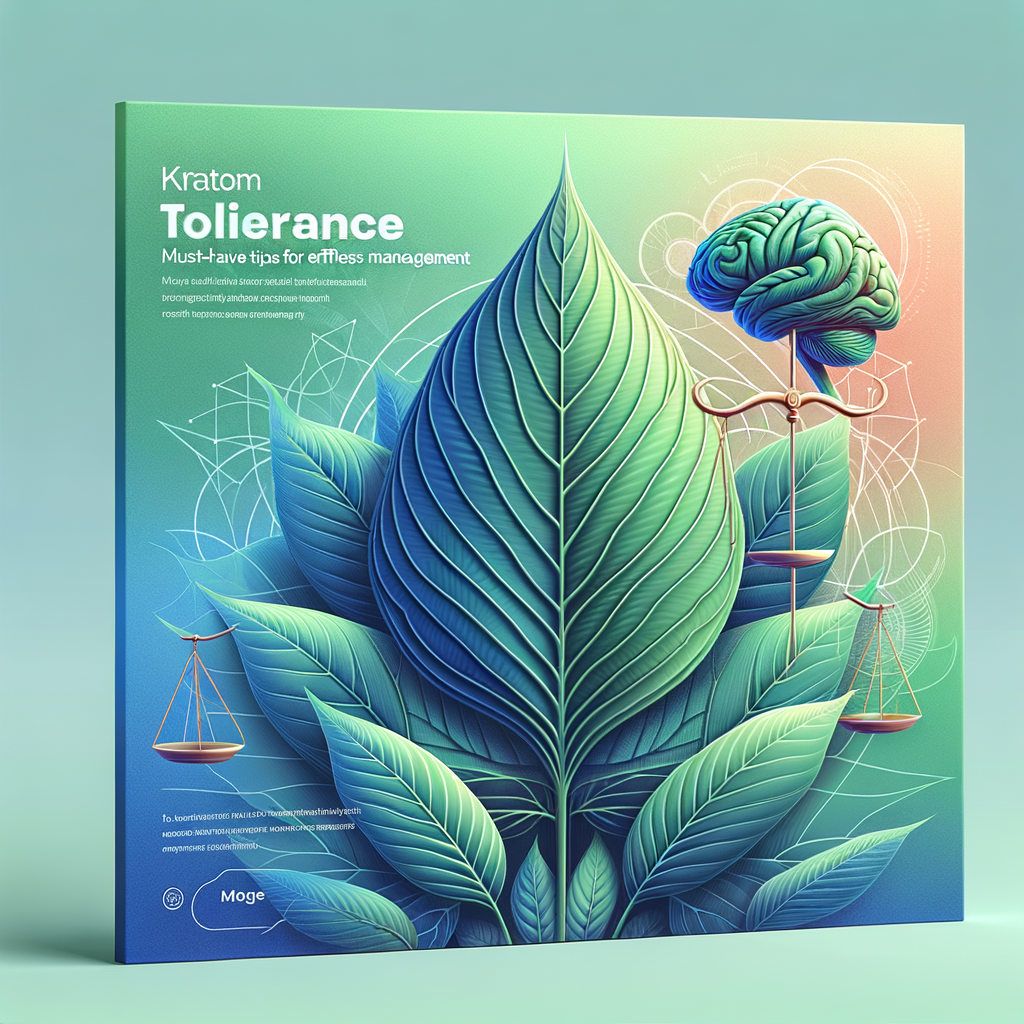
Kratom Tolerance: Must-Have Tips for Effortless Management
- Understanding Kratom Tolerance: An Overview
- Signs of Kratom Tolerance
- Factors Contributing to Tolerance
- Tips for Managing Kratom Tolerance
- 1. Cycle Your Usage
- 2. Reduce Dosage Gradually
- 3. Explore Different Strains
- 4. Stay Hydrated and Maintain a Healthy Diet
- 5. Incorporate Tolerance Breaks
- 6. Practice Mindfulness
- The Role of Dosage in Tolerance
- Recommended Dosages
- Signs of Overdosing
- Lifestyle Changes to Support Kratom Use
- Regular Exercise
- Getting Enough Sleep
- Reducing Stress
- FAQs About Kratom Tolerance
- 1. What is kratom tolerance?
- 2. How can I tell if I have developed a tolerance?
- 3. How long does it take to develop tolerance?
- 4. Is it safe to take kratom every day?
- 5. What are the best practices for dosing kratom?
- 6. Can I mix different kratom strains?
- 7. How long should my tolerance breaks be?
- 8. Can diet affect kratom tolerance?
- 9. What if I experience side effects from kratom?
- 10. Is kratom safe for everyone?
- Conclusion
- References
Understanding Kratom Tolerance: An Overview

Kratom, a natural herb from Southeast Asia, has gained immense popularity for its various effects. People use it for pain relief, mood enhancement, and energy boosting. However, one issue often arises: tolerance. If you’re a regular user, you might notice that you need to take more to achieve the same effects. Understanding and managing kratom tolerance can enhance your experience and ensure that you use this herb more effectively.
The body can adapt to substances over time. This means that the more you use kratom, the less effective it may become. Fortunately, there are strategies to manage this. By understanding tolerance, recognizing its signs, and implementing effective management techniques, you can make your kratom journey smoother.
Signs of Kratom Tolerance
Recognizing the signs of increasing tolerance is crucial. If you find yourself needing a higher dosage of kratom to feel its effects, this is the first red flag. Additionally, you might experience less intense effects with the same amount. These signs indicate that your body is adjusting to the alkaloids present in kratom.
Another sign to watch for is a diminished response to your usual doses. You may feel the urge to increase your intake, thinking this will solve the problem. However, this can lead to a cycle of dependence. Understanding these signs helps you make the necessary adjustments quickly.
Factors Contributing to Tolerance
Multiple factors contribute to kratom tolerance. Firstly, frequency of use plays a significant role. The more consistently you consume kratom, the more likely you are to develop tolerance. For instance, daily users often find their effects lessen over time.
Secondly, dosage matters. Higher doses can accelerate tolerance development. If you consistently take large amounts, your body may adjust faster. This is why it’s essential to pay attention to how much you’re consuming and how frequently.
Lastly, individual biology also contributes. Factors like metabolism, genetics, and overall health can affect how your body reacts to kratom. Each person’s experience is unique, making it essential to tailor your approach to your specific situation.
Tips for Managing Kratom Tolerance
1. Cycle Your Usage
Cycling your kratom use is one of the most effective ways to manage tolerance. Instead of taking kratom daily, consider taking breaks. For instance, using kratom for three days and taking four days off can help reset your body’s sensitivity. This allows your receptors to regain their responsiveness, enhancing the effects when you use kratom again.
2. Reduce Dosage Gradually
If you find yourself increasing your dose regularly, it’s time to rethink your strategy. Gradually reduce your dosage instead of making drastic changes. Discontinuing use suddenly might lead to withdrawal symptoms. A gradual decrease gives your body time to adjust and can help mitigate any discomfort.
3. Explore Different Strains
Kratom has various strains, each with unique alkaloid profiles. Switching strains may help you regain sensitivity. For example, if you regularly use a red strain, try a green or white strain for a change. This approach can provide similar effects while allowing your body to reset.
4. Stay Hydrated and Maintain a Healthy Diet
General health plays a significant role in how your body handles kratom. Staying hydrated is crucial. Water helps your body process the herb more effectively. A balanced diet rich in vitamins and minerals also supports your body’s systems. Foods high in antioxidants, like berries and green vegetables, can promote better overall health.
5. Incorporate Tolerance Breaks
In addition to cycling, you should also consider longer tolerance breaks. Regularly stepping away from kratom every few weeks can reset your system. A break of at least a week or two allows your body to recover. It also gives you time to explore other natural remedies for discomfort or mood enhancement.
6. Practice Mindfulness
Mindfulness can significantly enhance your kratom experience. By being aware of how kratom affects your body and mind, you can better understand your needs. Mindful usage helps you recognize when you genuinely need kratom versus when it’s a habit. Pay attention to its effects, and adjust your consumption accordingly.
The Role of Dosage in Tolerance
Recommended Dosages
Understanding the right dosage is vital in managing tolerance. Here’s a basic guideline:
| Experience Level | Recommended Dose (grams) |
|——————|————————–|
| Beginner | 2 – 4 |
| Intermediate | 4 – 6 |
| Advanced | 6 – 8 |
These figures are general. Individual experience may vary based on factors like weight, tolerance, and strain. Starting with lower doses and gradually increasing is generally advisable.
Signs of Overdosing
Taking too much kratom can lead to unpleasant effects. Signs of overdosing include nausea, dizziness, and severe drowsiness. If you experience these, consider reevaluating your dosage. It’s essential to strike a balance between effectiveness and safety.
Lifestyle Changes to Support Kratom Use
Regular Exercise
Regular physical activity can enhance your overall health and help mitigate tolerance. Exercise boosts your metabolism, improving how your body processes substances like kratom. Furthermore, it releases endorphins, which improve mood without relying solely on kratom.
Getting Enough Sleep
Quality sleep cannot be overlooked. Good sleep promotes better nerve function and overall well-being. Poor sleep can heighten the perception of pain and discomfort, leading you to rely more on kratom. Prioritizing sleep helps manage your tolerance effectively.
Reducing Stress
Stress management is key to minimizing reliance on substances, including kratom. Engaging in relaxation techniques like meditation, yoga, or even deep breathing can lower stress levels. The more relaxed you feel, the less likely you are to turn to kratom for comfort.
FAQs About Kratom Tolerance
1. What is kratom tolerance?
Kratom tolerance occurs when your body adapts to the effects of kratom. This means you need higher doses to achieve the same effects.
2. How can I tell if I have developed a tolerance?
Signs include needing larger doses for similar effects, diminished effects from your usual dosage, or feeling less energetic.
3. How long does it take to develop tolerance?
It varies by individual, but frequent use over a few weeks can lead to noticeable tolerance.
4. Is it safe to take kratom every day?
Daily use can lead to quick tolerance and potential dependence. It’s advisable to take breaks.
5. What are the best practices for dosing kratom?
Start with a low dose and gradually increase as needed. Monitor how your body responds to find a comfortable level.
6. Can I mix different kratom strains?
Yes, some users find that mixing strains can enhance effects and help manage tolerance, but start slow to gauge your reaction.
7. How long should my tolerance breaks be?
A break of one to two weeks is generally recommended, but it can vary by individual preference.
8. Can diet affect kratom tolerance?
Yes, a healthy diet can improve overall health, which may help your body process kratom more efficiently.
9. What if I experience side effects from kratom?
If you experience side effects, consider lowering your dose or taking a break. Consult a healthcare professional if symptoms persist.
10. Is kratom safe for everyone?
Kratom isn’t suitable for everyone, especially those with certain health conditions or those taking specific medications. Consultation with a healthcare provider is beneficial.
Conclusion
Understanding and managing kratom tolerance is vital for both new and experienced users. Recognizing the signs, implementing useful strategies, and making lifestyle changes can significantly enhance your experience. With the right approach, you can enjoy the benefits of kratom while minimizing the risk of tolerance and dependence.
References
1. https://www.ncbi.nlm.nih.gov/pmc/articles/PMC6492314/
2. https://www.ncbi.nlm.nih.gov/pmc/articles/PMC6363072/
3. https://www.healthline.com/health/kratom
4. https://www.webmd.com/vitamins/ai/ingredientmono-1001/kratom


